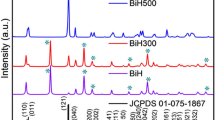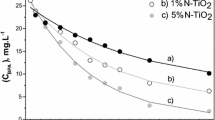Abstract
In this study, BiVO4 powder is prepared and used as a visible-light catalyst for the photocatalytic degradation of alachlor. The as-prepared BiVO4 photocatalyst is characterized by X-ray diffraction (XRD), scanning electron microscopy (SEM), UV–vis diffuse reflectance spectra (DRS), and BET surface area analysis. Alachlor could be successfully degraded in the presence of both H2O2 and BiVO4 catalyst under visible-light irradiation. With optimal operating parameters, its degradation efficiency could reach 97 % in 6 h. Factors such as solution pH, catalyst dosage, and the presence of anions are found to influence the degradation rate. To scrutinize the mechanistic details of the alachlor photodegradation, the intermediates of the process are separated, identified, and characterized by solid-phase microextraction (SPME) and gas chromatography/mass spectrometry (GC/MS). Results suggest that possible transformation pathways may include oxidation of the arylethyl group, cleavage of the N-methoxymethyl group, and N-chloroacetyl moiety.












Similar content being viewed by others
References
Bagal, M. V., & Gogate, P. R. (2012). Sonochemical degradation of alachlor in the presence of process intensifying additives. Separation and Purification Technology, 90, 92–100.
Ballesteros Martin, M. M., Sanchez Perez, J. A., Garcia Sanchez, J. L., Montes de Oca, L., Casas Lopez, J. L., Oller, I., & Malato Rodriguez, S. (2008). Degradation of alachlor and pyrimethanil by combined photo-Fenton and biological oxidation. Journal of Hazardous Materials, 155, 342–349.
Castillo, N. C., Ding, L., Heel, A., Graule, T., & Pulgarin, C. (2010). On the photocatalytic degradation of phenol and dichloroacetate by BiVO4: the need of a sacrificial electron acceptor. Journal of Photochemistry and Photobiology A: Chemistry, 216, 221–227.
Chan, C. Y., Tao, S., Dawson, R., & Wong, P. K. (2004). Treatment of atrazine by integrating photocatalytic and biological processes. Environmental Pollution, 131, 45–54.
Chen, C. C., Lu, C. S., Mai, F. D., & Weng, C. S. (2006). Photooxidative N-de-ethylation of anionic triarylmethane dye (sulfan blue) in titanium dioxide dispersions under UV irradiation. Journal of Hazardous Materials, B137, 1600–1607.
Choi, D., Lee, O. M., Yu, S., & Jeong, S. W. (2010). Gamma radiolysis of alachlor aqueous solutions in the presence of hydrogen peroxide. Journal of Hazardous Materials, 184, 308–312.
Chu, W., Choy, W. K., & So, T. Y. (2007). The effect of solution pH and peroxide in the TiO2-induced photocatalysis of chlorinated aniline. Journal of Hazardous Materials, 141, 86–91.
Cruz, A. M., & Perez, U. M. G. (2010). Photocatalytic properties of BiVO4 prepared by the coprecipitation method: degradation of rhodamine B and possible reaction mechanisms under visible irradiation. Materials Research Bulletin, 45, 135–141.
Dong, L., Guo, S., Zhu, S., Xu, D., Zhang, L., Huo, M., & Yang, X. (2011). Sunlight responsive BiVO4 photocatalyst: Effects of pH on L-cysteine-assisted hydrothermal treatment and enhanced degradation of ofloxacin. Catalysis Communications, 16, 250–254.
Dong, S., Yu, C., Li, Y., Li, Y., Sun, J., & Geng, X. (2014). Controlled synthesis of T-shaped BiVO4 and enhanced visible light responsive photocatalytic activity. Journal of Solid State Chemistry, 211, 176–183.
Environmental Protection Agency. National primary drinking water regulations. Washington, DC, 2001.
European Union. European Communities (Drinking Water) No. 2 Regulations 2007. SI No. 278, Brussels, 2007. p. 22–23.
Gan, Q., & Jans, U. (2007). Nucleophilic reactions of phorate and terbufos with reduced sulfur species under anoxic conditions. Journal of Agricultural and Food Chemistry, 55, 3546–3554.
Hong, S., & Lemley, A. T. (1998). Gas chromatographic–mass spectrometric determination of alachlor and its degradation products by direct aqueous injection. Journal of Chromatography A, 822, 253–261.
Katsumata, H., Kaneco, S., Suzuki, T., Ohta, K., & Yobiko, Y. (2006). Photo-Fenton degradation of alachlor in the presence of citrate solution. Journal of Photochemistry and Photobiology A: Chemistry, 180, 38–45.
Kim, M. S., Ryu, C. S., & Kim, B. W. (2005). Effect of ferric ion add on photodegradation of alachlor in the presence of TiO2 and UV radiation. Water Research, 39, 525–532.
Kohtani, S., Tomohiro, M., Tokumura, K., & Nakagaki, R. (2005). Photooxidation reactions of polycyclic aromatic hydrocarbons over pure and Ag-loaded BiVO4 photocatalysts. Applied Catalysis B: Environmental, 58, 265–272.
Konstantinou, I. K., & Albanis, T. A. (2004). TiO2-assisted photocatalytic degradation of azo dyes in aqueous solution: kinetic and mechanistic investigations, a review. Applied Catalysis B: Environmental, 49, 1–14.
Koskinen, W. C., Sellung, J. M., Baker, J. M., Barber, B. L., & Dowdy, R. H. (1994). Ultrasonic decomposition of alachlor and atrazine in water. Journal of Environmental Science and Health. Part. B, 29, 581–590.
Kudo, A., Omori, K., & Kato, H. (1999). A novel aqueous process for preparation of crystal form-controlled and highly crystalline BiVO4 powder from layered vanadates at room temperature and its photocatalytic and photophysical properties. Journal of the American Chemical Society, 121, 11459–11467.
Leng, W., Liu, H., Cheng, S., Zhang, J., & Cao, C. (2000). Kinetics of photocatalytic degradation of aniline in water over TiO2 supported on porous nickel. Journal of Photochemistry and Photobiology A: Chemistry, 131, 125–132.
Liang, N., Wang, M., Jin, L., Huang, S., Chen, W., Xu, M., He, Q., Zai, J., Fang, N., & Qian, X. (2014a). Highly efficient Ag2O/Bi2O2CO3 p-n heterojunction photocatalysts with improved visible-light responsive activity. ACS Applied Materials & Interfaces, 6, 11698–11705.
Liang, N., Zai, J., Xu, M., Zhu, Q., Wei, X., & Qian, X. (2014b). Novel Bi2S3/Bi2O2CO3 heterojunction photocatalysts with enhanced visible light responsive activity and wastewater treatment. Journal of Materials Chemistry A, 2, 4208–4216.
Lin, X., Yu, L., Yan, L., Li, H., Yan, Y., Liu, C., & Zhai, H. (2014). Visible light photocatalytic activity of BiVO4 particles with different morphologies. Solid State Sciences, 32, 61–66.
Mahmoodi, N. M., Arami, M., Limaee, N. Y., & Gharanjig, K. (2007). Photocatalytic degradation of agricultural N-heterocyclic organic pollutants using immobilized nanoparticles of titania. Journal of Hazardous Materials, 145, 65–71.
Muñoz-Batista, M. J., Ballari, M. M., Kubacka, A., Cassano, A. E., Alfano, O. M., & Fernández-García, M. (2014). Acetaldehyde degradation under UV and visible irradiation using CeO2–TiO2 composite systems: Evaluation of the photocatalytic efficiencies. Chemical Engineering Journal, 255, 297–306.
Potter, T. L., & Carpenter, T. L. (1995). Occurrence of alachlor environmental degradation products in groundwater. Environmental Science & Technology, 29, 1557–1563.
Qiang, Z., Liu, C., Dong, B., & Zhang, Y. (2010). Degradation mechanism of alachlor during direct ozonation and O3/H2O2 advanced oxidation process. Chemosphere, 78, 517–526.
Ren, J., Wang, W., Shang, M., Sun, S., & Gao, E. (2011). Heterostructured bismuth molybdate composite: preparation and improved photocatalytic activity under visible-light irradiation. ACS Applied Materials & Interfaces, 3, 2529–2533.
Russell, G. A. (1957). Deuterium isotope effects in the autooxidation of aralkyl hydrocarbons. Mechanism of the interaction of peroxy radicals. Journal of the American Chemical Society, 79, 3871–3877.
Ryu, C. S., Kim, M. S., & Kim, B. W. (2003). Photodegradation of alachlor with the TiO2 film immobilised on the glass tube in aqueous solution. Chemosphere, 53, 765–771.
Sauleda, R., & Brillas, E. (2001). Mineralization of aniline and 4-chlorophenol in acidic solution by ozonation catalyzed with Fe2+ and UVA light. Applied Catalysis B: Environmental, 29, 135–145.
Shang, M., Wang, W., Sun, S., Ren, J., Zhou, L., & Zhang, L. (2009). Efficient visible light induced photocatalytic degradation of contaminant by spindle-like PANI/BiVO4. Journal of Physical Chemistry C, 113, 20228–20233.
Sun, S., Wang, W., Zhou, L., & Xu, H. (2009). Efficient methylene blue removal over hydrothermally synthesized starlike BiVO4. Industrial & Engineering Chemistry Research, 48, 1735–1739.
Tokunaga, S., Kato, H., & Kudo, A. (2001). Selective preparation of monoclinic and tetragonal BiVO4 with scheelite structure and their photocatalytic properties. Chemistry of Materials, 13, 4624–4628.
Torres, R. A., Mosteo, R., Petrier, C., & Pulgarin, C. (2009). Experimental design approach to the optimization of ultrasonic degradation of alachlor and enhancement of treated water biodegradability. Ultrasonics Sonochemistry, 16, 425–430.
Wang, X., & Zhang, Y. (2009). Degradation of alachlor in aqueous solution by using hydrodynamic cavitation. Journal of Hazardous Materials, 161, 202–207.
Wang, K. H., Hisieh, Y. H., Wu, C. H., & Chang, C. Y. (2000). The pH and anion effects on the heterogeneous photocatalytic degradation of o-methylbenzoic acid in TiO2 aqueous suspension. Chemosphere, 40, 389–394.
Wang, C. Y., Zhang, H., Li, F., & Zhu, L. Y. (2010). Degradation and mineralization of bisphenol A by mesoporous Bi2WO6 under simulated solar light irradiation. Environmental Science & Technology, 44, 6843–6848.
Wong, C. C., & Chu, W. (2003). The direct photolysis and photocatalytic degradation of alachlor at different TiO2 and UV sources. Chemosphere, 50, 981–987.
Xiao, Q., Zhang, J., Xiao, C., & Tan, X. K. (2008). Photocatalytic degradation of methylene blue over Co3O4/Bi2WO6 composite under visible light irradiation. Catalysis Communications, 9, 1247–1253.
Xie, B., Zhang, H., Cai, P., Qiu, R., & Xiong, Y. (2006). Simultaneous photocatalytic reduction of Cr(VI) and oxidation of phenol over monoclinic BiVO4 under visible light irradiation. Chemosphere, 63, 956–963.
Xin, Y., Liu, H., Han, L., & Zhou, Y. (2011). Comparative study of photocatalytic and photoelectrocatalytic properties of alachlor using different morphology TiO2/Ti photoelectrodes. Journal of Hazardous Materials, 192, 1812–1818.
Xu, X. R., Zhao, Z. Y., Li, X. Y., & Gu, J. D. (2004). Chemical oxidative degradation of methyl tert-butyl ether in aqueous solution by Fenton’s reagent. Chemosphere, 55, 73–79.
Ye, X., Chen, D., Li, K., Shah, V., Kesmez, M., & Vajifdar, K. (2007). Photocatalytic oxidation of aldehydes/PCE using porous anatase titania and visible-light-responsive brookite titania. Chemical Engineering Communications, 194, 368–381.
Yu, J., Zhang, L., Cheng, B., & Su, Y. (2007). Hydrothermal preparation and photocatalytic activity of hierarchically sponge-like macro-/mesoporous titania. Journal of Physical Chemistry C, 111, 10582–10589.
Zhao, T., Zai, J., Xu, M., Zou, Q., Su, Y., Wang, K., & Qian, X. (2011). Hierarchical Bi2O2CO3 microspheres with improved visible-light-driven photocatalytic activity. CrystEngComm, 13, 4010–4017.
Zhu, J. H., Yan, X. L., Liu, Y., & Zhang, B. (2006). Improving alachlor biodegradability by ferrate oxidation. Journal of Hazardous Materials, B135, 94–99.
Zhuo, Y., Huang, J., Cao, L., Ouyang, H., & Wu, J. (2013). Photocatalytic activity of snow-like Bi2WO6 microcrystalline for decomposition of Rhodamine B under natural sunlight irradiation. Materials Letters, 90, 107–110.
Acknowledgments
This research was supported by the National Science Council of the Republic of China (NSC 102-2113-M-025-001).
Author information
Authors and Affiliations
Corresponding author
Electronic supplementary material
Below is the link to the electronic supplementary material.
ESM 1
(DOC 468 kb)
Rights and permissions
About this article
Cite this article
Chang, YK., Wu, YS., Lu, CS. et al. Photodegradation of Alachlor Using BiVO4 Photocatalyst Under Visible Light Irradiation. Water Air Soil Pollut 226, 194 (2015). https://doi.org/10.1007/s11270-015-2452-0
Received:
Accepted:
Published:
DOI: https://doi.org/10.1007/s11270-015-2452-0




